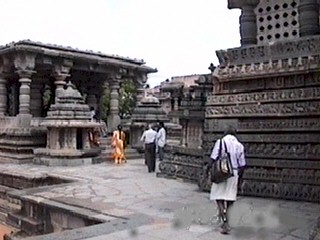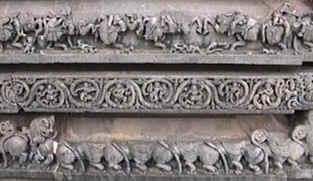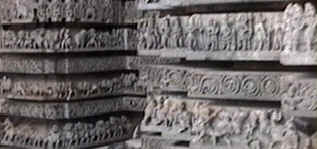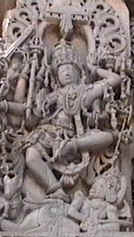Abodes of Ganesha
Temples of Tamilnadu
|

Halebidu
Temples of Karnataka
Temple of the Month - June 2000
Halebidu the ancient Hoysala capital houses the ornate Hoysaleswara and Kedareswara temples, and is one of the well visited tourist attractions of Karnataka. Halebidu is located at a distance of 149 km from Mysore and 31 km from Hassan. The Karnataka State Tourism Bureau offers a rather hectic tour package (from Mysore) covering Sravanabelagola, Halebidu and Belur in one day.
The Hoysaleswara temple dates back to the 12th century CE. It was built by Ketamalla a minister of Vishnuvardhana the Hoysala ruler who also built the Belur temple and the Mahabaleshwar temple at Chamundi Hills near Mysore. Halebidu was sacked by the armies of Malik Kafur in early fourteenth century, after which it fell into a state of disrepair and neglect.
The Hoysaleswara temple enshrines Hoysaleswara and Santaleswara. Hoysaleswara is named after the builder Vishnuvardhana Hoysala and Santaleswara after his wife, Queen Santala. The sancta are built on a stellar plan, with a sukhanasi, navaranga and Nandi Mandapa. Each of these (temples) resembles the Belur Chennakesava temple in plan.
The Hoysaleswara temple is a masterpiece, studded with a profusion of carvings. Thousands of figures appear on its walls. The basement of the temple has the most richly sculptured friezes. Horsemen charge, war elephants charge, all in stone. Scenes from the Ramayana and the Mahabharata add to the grandeur.
Art historian James Fergusson writes of Halebidu thus The Hoysaleswara temple may be probably considered as one of the most marvellous exhibitions of human labor to be found even the patient east. The mode in which the eastern face is broken up by the larger masses, so as to give height and play of light and shade, is a better way of accomplishing what the Gothc artists attempted by their projections. This however is surpassed by the western front, where the variety of outline and arrangement and subordination of the various facets in which it is disposed, must be considered as a masterpiece of design in its class.
If the friezes were to be spread olong a plain surface, it would lose more than half its effect, while the vertical angles, without interfering with the continuity of the frieze give height and strength to the whole composition. The disposition of the horizontal lines of the lower friezes is equally effective. Here again, the artistic combination of horizongal and vertical lines and the play of outline and of light and shate far surpass anything in gothic art.
There are pierced windows on the walls, about a meter high each, with divinities set on pedestals with canopies above. The south door is beautifully sculptured.
The Kedareswara temple built by King Ballala II, at Halebidu now in ruins is considered to be a a gem of architecture. As with the Hoysaleswara temple, this temple has classic friezes, and scenes from the epics. There are a hundred and eighty images set under floral toranas in the upper parts of the walls. Also nearby, are Jain temples dedicated to Parsvanatha, Santhanatha and Adinatha.
See Also:
Belur
Sravanabelagola
Chamundi Hills
Srirangapatna



